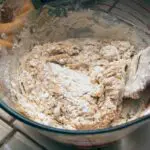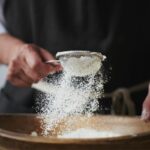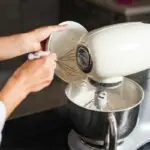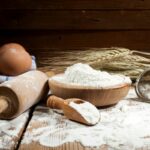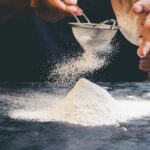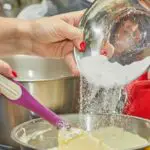If you’re about to make cookies and find you don’t have the all-purpose flour called for in the cookies’ recipe, it could be worth going to the store to get more. However, you might have some self-rising flour in your cupboard and think to yourself “Why not?”
Most of us have definitely tried replacing all-purpose flour with self-rising flour at least once in our lives when we just could not be bothered to pop to the supermarket to buy an extra package of plain flour.
However, was that the right choice? Can we actually use self-rising flour for cookies? Keep reading to find out!
What Is Self-Rising Flour?
Self-rising flour is basically a cornstarch and salt combination that is meant to keep baked items constantly moistened whilst minimizing the necessity for raising ingredients like baking powder.
Self-rising flour can also be used to substitute the components stated in a baking recipe or as an addition to substitute the baking powder or bicarbonate of soda included in traditional baking goods.
Self-rising flour is a kind of raising agent that expands to double its actual size when coupled with an acid fluid, such as vinegar.
That is why most baking recipes that need self-rising flour also want you to include eggs in the mix as they are also acidic. The liquids help with the activation of the yeast that is in the self-rising flour, allowing it thus to rise.
Invention Of Self-Rising Flour
A baker named L. Prang invented self-rising flour in the 19th century. This flour is a form of baking powder that lacks sodium bicarbonate, which allows baking soda to puff. Rather, an alkaline solution, such as sodium aluminum sulfate, is present.
Although it will not work in every single baked good, self-rising flour can be used to make cookies if the necessary modifications are made.
In contrast to all-purpose flour, self-rising flour contains more than just wheat. It also comprises salt and baking powder, which makes it look like a baking mix.
Can Self-Rising Flour Be Used As A Replacement Of All-Purpose Flour To Bake Cookies?
In most recipes, you can swap an equal amount of self-rising flour for the quantity of all-purpose flour called in for a cookie recipe.
Therefore, it is more than fine to add self-rising flour in a recipe that calls for a cup of all-purpose flour and a teaspoon of baking powder.
In fact, many cookie recipes include self-rising flour as the main ingredient that will help them puff.
Since all cookie recipes require baking powder in one way or another, and baking powder is already included in the self-rising flour blend, it is much easier to use that from the beginning to avoid adding separately other ingredients like extra salt and baking soda (apart from baking powder).
How Can I Substitute All-Purpose Flour For Self-Rising Flour?
To substitute all-purpose flour for self-rising flour, leave out the baking powder and reduce the sodium in the basic recipes.
This approach is perfect for muffins, cakes, and other products that do not require bicarbonate of soda or acidic ingredients.
The end product is also better since the above-mentioned components have been nicely mixed in the self-rising flour blend. For instance, one cup of self-rising flour already contains 1 1/2 tsp of baking powder.
As a result, when you are baking a signature cake of yours, but you are short on baking soda, simply substitute the all-purpose flour for self-rising flour.
What Happens When I Mix Self-Rising Flour With Baking Powder?
Many sponge cakes, like Victoria sponges and muffins, require the correct quantity of baking powder. Never add less baking powder or bicarbonate of soda if the recipe mentioned a specific amount.
Can You Use Self-Rising Flour With Yeast In A Recipe?
Sodium bicarbonate is already a leavening agent in self-rising flour.
Mixing baking soda with yeast gives no advantage to your dough and may even disrupt the chemical interactions of the other components. Because of that, bread machines’ instruction books warn against the use of self-rising flour.
Can You Use Self-Rising Flour With Salt In A Recipe?
Sodium bicarbonate is already a leavening agent in self-rising flour. Mixing baking soda with yeast gives no advantage to your dough and may even disrupt the chemical interactions of the other components. Because of that, bread machines’ instruction books warn against the use of self-rising flour.
Because self-rising flour contains baking powder and salt, the proportions in your recipes will have to be adjusted.
Self-rising flour may produce a lighter result according to each recipe, but any recipes requiring more than 1/4 tsp of either baking powder or salt could have a detrimental effect on taste and texture.
Is Baking Soda Necessary When Using Self-Rising Flour?
1 to 1 1/2 teaspoons of baking powder are included in each cup of self-rising flour.
Therefore, even though you can swap all-purpose flour for self-rising flour to make your cookies if you’re running short on baking soda, you will have to proceed with a few tweaks to make sure that the acidic balance is kept.
What Should I Do If I Don’t Have Any All-Purpose Flour In My Cupboard?
If you need to substitute all-purpose flour, follow these simple steps:
- 1 cup whole-wheat flour = 1/2 cup all-purpose flour + 1/2 cup whole-wheat flour
- 1 cup all-purpose = 1/2 cup whole wheat + 1/2 cup all-purpose (white).
- 1 cup white all-purpose flour plus 1 cup soft white wheat flour (also known as whole-wheat baking flour).
The Bottom Line
To sum it all up, even though you may use self-rising flour for all-purpose flour, the results may vary based on the recipe you are following.
Therefore, your cookies could end up having a different texture, be thinner or thicker than normal, or fail to brown properly.
If you cannot find the right flour, you might conclude that replacing it with self-rising flour is worth a shot. However, when it comes to baking, it is probably best to stick with what the recipe’s ingredients list asks for.


